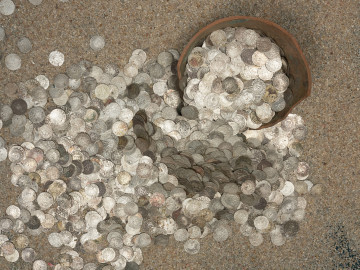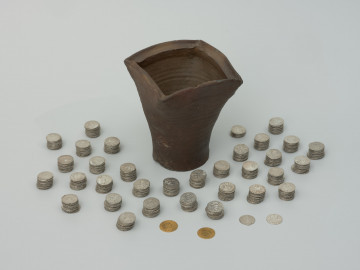
Treasure of coins
1507 — 1660
National Museum in Szczecin
Part of the collection: Treasures of coins from Western Pomerania
In 1969, during construction work in Pyrzyce, a treasure of late medieval coins was discovered. In a small clay pot, there were small, inscriptionless Pomeranian denarii, called Vinkenaugen. They were accompanied by few foreign coins from Poland, Brandenburg, Saxony and Sweden. Part of the find was dispersed, but eventually, 2588 coins and a large vessel fragment found their way to the museum collection. All the coins in the treasure are uniform in style, not neatly minted and not very sophisticated in content. The denarii of Pomeranian towns and cities, especially Szczecin (782 items), Pyrzyce (367 items) and Stargard (110 items), dominate in number. The remaining coins come from the mints of the bishops of Kamień (267 items) and the minting workshops of Pomeranian dukes. Dukes, granting minting privileges to towns, ordered the griffin sign to be placed on the stamp as the state and dynasty emblem. The main side of the denarii bore the symbol of the city, in Szczecin - a three-tower gate with a helmet in the clearance, Pyrzyce - a rosette, or Stargard - a star, while the reverse bore the image of a walking griffin. The chronological span of the set is approximately 100 years, but most of its components are close to the second half of the 14th century. The identification of the oldest coin is not very precise due to the anonymous nature of Vinkenaugen. It is assumed, through another dating such as foreign coins bearing the ruler's name on them, that the treasure was hidden after 1405-1410. The Pyrzyce treasure presents a denary picture of Pomeranian minting at the turn of the 14th/15th century. It was the period of the most remarkable development of cities, which, thanks to the Duke's grants and privileges, achieved great political and economic independence. Attention is drawn to the numerous denarii of the Kamień Pomorski, bishops which stemmed from minting rights resulting from their jurisdiction over the Kołobrzeg and Kamień Pomorski lands.
Genowefa Horoszko
Author / creator
Dimensions
cały obiekt:
Object type
vessel, coin
Technique
minting, firing in redox atmosphere, forming
Material
silver, ceramic
Creation time / dating
Creation / finding place
Owner
National Museum in Szczecin
Identification number
Location / status

1507 — 1660
National Museum in Szczecin

XV wiek
National Museum in Szczecin

1414 — 1495
National Museum in Szczecin
DISCOVER this TOPIC
National Museum in Lublin
DISCOVER this PATH
Educational path